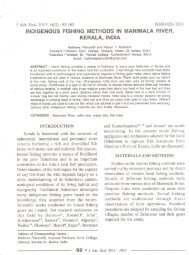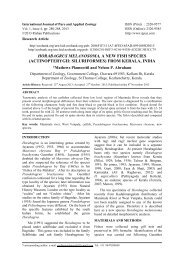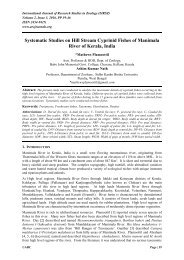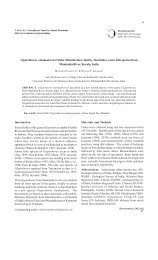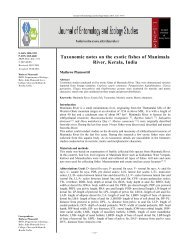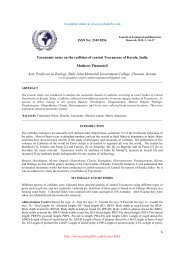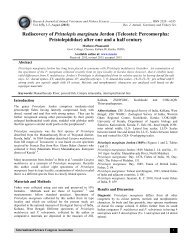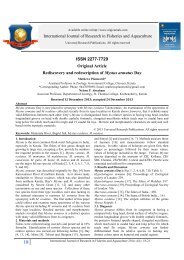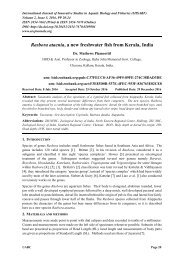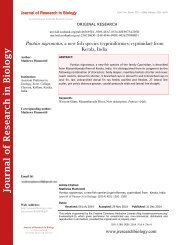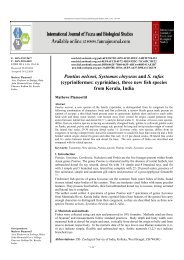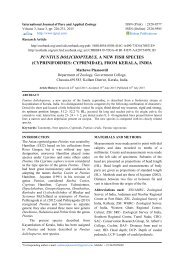Mastacembelus malabaricus..Redescription
Create successful ePaper yourself
Turn your PDF publications into a flip-book with our unique Google optimized e-Paper software.
Research Journal of Animal, Veterinary and Fishery Sciences ___________________________ ISSN 2320 – 6535<br />
Vol. 1(8), 6-11, September (2013)<br />
Res. J. Animal, Veterinary and Fishery Sci.<br />
Rediscovery of <strong>Mastacembelus</strong> <strong>malabaricus</strong> after one and Half Century<br />
Abstract<br />
Mathews Plamoottil 1 and Nelson P. Abraham 2<br />
1 Govt. College, Chavara, Kollam Dt, Kerala, INDIA<br />
2 St. Thomas College, Kozhencherry, Kerala, INDIA<br />
Available online at: www.isca.in<br />
Received 8 th September 2013, revised 16 th September 2013, accepted 24 th September 2013<br />
<strong>Mastacembelus</strong> <strong>malabaricus</strong> Jerdon has long been placed in synonymy with <strong>Mastacembelus</strong> armatus and Macrognathus<br />
guentheri. An examination of the specimens of M. <strong>malabaricus</strong> collected recently from its type locality in Kerala shows<br />
however, that it exhibits many valid differences from its congeners. Jerdon’s spiny eel is distinguished from its relative<br />
species by having eleven large and conspicuous “X” marks on the mid lateral sides, 39- 40 dorsal spines, shorter head,<br />
shorter dorsal fin, lengthy base of dorsal fin, lesser pre dorsal and pre anal length and shorter dorsal and anal spines.<br />
Meristic and morphometric characters are analyzed well based on the topotypic materials.<br />
Keywords: Mananthavady River, spiny eel, <strong>Mastacembelus</strong> armatus, redescription.<br />
Introduction<br />
Spiny eels, belonging to the family Mastacembelidae, are eellike<br />
fishes with elongated and compressed body. Macrognathus<br />
and <strong>Mastacembelus</strong> are the two genera included in this family.<br />
Both these genera are distributed throughout India. Day 1<br />
recognized two genera of spiny eels, namely <strong>Mastacembelus</strong><br />
and Rhynchobdella under the family Rhynchobdellidae of the<br />
order Acanthopterigii. He recorded a single species,<br />
Rhynchobdella aculeata under the genus Rhynchobdella and<br />
five species under the genus <strong>Mastacembelus</strong>. Jayaram 2,3<br />
recognized two genera under Mastacembelidae viz.,<br />
Macrognathus Lacepede with six species and <strong>Mastacembelus</strong><br />
Scopoli with five species.<br />
Some taxonomists consider <strong>Mastacembelus</strong> <strong>malabaricus</strong> as a<br />
synonym of Macrognathus guentheri and some others as a<br />
synonym of <strong>Mastacembelus</strong> armatus. Recently the first author<br />
could collect a few specimens of <strong>Mastacembelus</strong> <strong>malabaricus</strong><br />
from its type locality, examination of which revealed that it is a<br />
different species from its closely related species.<br />
Material and Methods<br />
Fishes were collected using gill net and preserved in 10%<br />
formalin. Methods used are those of Jayaram 4 and<br />
measurements follow standard practices. Identification of the<br />
species and its comparison with the new species was carried out<br />
following Jerdon 5 Day 1,6,7 , Yazdani 8 , Talwar and Jhingran 9 and<br />
Jayaram 3 . In the table, values of holotype are given first, then<br />
ranges followed by their mean values. Body depth and body<br />
width are taken at the level of first dorsal spine; length of the<br />
longest dorsal and anal spine is counted as dorsal and anal spine<br />
lengths respectively. Abbreviations used: BDD- body depth at<br />
first dorsal spine; LDS- length of longest dorsal spine; DD & P-<br />
distance between first dorsal spine and pectoral base.<br />
Results and Discussion<br />
Diagnosis: <strong>Mastacembelus</strong> <strong>malabaricus</strong> can be distinguished<br />
from its congeners in having 39- 40 dorsal spines, an elongated<br />
body, shorter head, short dorsal fin, lengthy base of dorsal fin,<br />
lesser pre dorsal and pre anal length and shorter dorsal and anal<br />
spines. Unlike its relatives, body of M. <strong>malabaricus</strong> has eleven<br />
large and conspicuous “X” marks on the mid lateral sides.<br />
Figure-1<br />
<strong>Mastacembelus</strong> <strong>malabaricus</strong> collected from Mananthavady River<br />
International Science Congress Association 6
Research Journal of Animal, Veterinary and Fishery Sciences ________________________________________ ISSN 2320 – 6535<br />
Vol. 1(8), 6-11, September (2013)<br />
Res. J. Animal, Veterinary and Fishery Sci.<br />
Description: An eel shaped fish tapering to head and tail (figure<br />
1- 4). Head length 15.1- 17.0, body depth 5.8- 6.8 as % of<br />
standard length. Eyes small, 7.4- 10.6, interorbital space 5.3-<br />
7.5, length of snout 34.7- 38.3 as % of head length. The short<br />
snout has a trilobed extremity with a concave but unstriated<br />
lower surface. Length of gape of mouth, 11.3- 14.7 % of head<br />
length, gape extending below to anterior margin of posterior<br />
nostril; a moderately strong spine present forwards and<br />
downwards of orbit and in between it and the angle of jaws.<br />
Length of lower jaw 13.2- 17.7 as % of head length. Sharp teeth<br />
in bands in both jaws. Dorsal and anal fins confluent with the<br />
caudal.<br />
Figure-2<br />
Anterior region of <strong>Mastacembelus</strong> <strong>malabaricus</strong><br />
Figure-3<br />
Middle region of <strong>Mastacembelus</strong> <strong>malabaricus</strong><br />
Figure-4<br />
Posterior region of <strong>Mastacembelus</strong> <strong>malabaricus</strong><br />
International Science Congress Association 7
Research Journal of Animal, Veterinary and Fishery Sciences ________________________________________ ISSN 2320 – 6535<br />
Vol. 1(8), 6-11, September (2013)<br />
Res. J. Animal, Veterinary and Fishery Sci.<br />
Spines of dorsal fin originating above middle of pectoral fin,<br />
second last spine the longest, last spine small and hidden<br />
beneath the skin. Anal spines close together, second the largest,<br />
last small and hidden beneath the skin; soft anal fin originating<br />
slightly in advance of soft dorsal fin. Pectoral fin length 4.3-<br />
5.3 as % of standard length. Vent nearer to base of caudal than<br />
to snout. Caudal fin confluent with dorsal and anal fins; no<br />
notch at the point of its confluence. Top of snout, inter nasal<br />
space, inter orbital space and top of head as far as hind edge of<br />
pre operculum scale less. Two to three small and inconspicuous<br />
pre opercular spines or serrations present. Lateral line roughly<br />
straight but at above the origin of soft anal it is concave.<br />
Color: Body greenish brown or greenish yellow; eleven large<br />
and conspicuous “X” marks present on the mid lateral sides on<br />
the middle region of the body; in front of it in the anterior<br />
region four large, round and conspicuous black spots; a number<br />
of brownish black dots present above and below ‘X’ marks.<br />
Three rows of large and conspicuous black spots present on the<br />
caudal region; twenty large and conspicuous round spots present<br />
on the dorso- lateral side just below mid dorsal line; pectoral fin<br />
with three dots of black dots in the form of lines; below it at the<br />
base of pectoral a large round black spot present. From the eyes<br />
three brownish black lines in the form of elongated dots up to<br />
opercle. One or two lines may go to ventral side of opercle, but<br />
not united with those on the other side. A brownish black line<br />
in the form of dots originate from the middle of pectoral fin<br />
considerably below lateral line and reach below up to 15 th dorsal<br />
spine; it is distinct but in the form of scattered dots. Another<br />
brownish black line formed by the joining of 2 or 3 elongated<br />
dots starts from below pectoral and reach up to a little behind<br />
posterior tip of pectoral. These two lines are in the form of dots<br />
and not in the form of line in young specimens. Basic color<br />
pattern is constant in all the fishes of the species.<br />
Distribution: Currently known only from Mananthavady River,<br />
Wayanad, Kerala, India.<br />
Table-1<br />
Morphometric characters of <strong>Mastacembelus</strong> <strong>malabaricus</strong><br />
SL. No Characters Range Mean SD<br />
1 Total length 297.5- 419.0 345.1 57.4<br />
2 Standard length 285.0- 400.0 330.8 55.0<br />
Percentage of Standard Length<br />
3 Head Length 15.1- 17.0 16.4 0.8<br />
4 Body depth 5.8- 6.8 6.3 0.4<br />
5 Body width 4.6- 5.3 4.8 0.3<br />
6 Length of pectoral 4.3- 5.3 4.8 0.5<br />
7 Height of soft dorsal fin 1.4- 2.0 1.7 0.4<br />
8 Length of dorsal spine 1.5- 2.3 1.9 0.3<br />
9 Height of soft anal fin 1.1-1.3 1.2 0.1<br />
10 Height of anal spine 2.3- 3.5 2.8 0.4<br />
11 Length of caudal fin 3.4- 4.9 4.4 0.7<br />
12 Length of base of soft dorsal fin 35.8- 39.1 37.1 1.5<br />
13 Length of base of spinous dorsal fin 43.0- 45.6 44.2 1.3<br />
14 Length of base of soft anal fin 36.8- 41.3 38.9 2.4<br />
15 Length of base of spinous anal fin 2.5- 3.8 3.1 0.6<br />
16 Length of base of pectoral 1.9- 2.1 2 0.1<br />
17 Pre dorsal length 17.1- 19.0 18.3 0.8<br />
18 Pre anal length 56.6- 58.8 58 0.9<br />
19 Head length (mm) 47.0-68.0 54.25 9.5<br />
Percentage of head length<br />
20 Head depth 37.2- 39.2 38.2 0.9<br />
21 Head width 25.3- 29.8 28.2 1.9<br />
22 Eye diameter 7.4- 10.6 9.4 1.4<br />
23 Snout length 34.7- 38.3 36.6 1.7<br />
24 Inter orbital width 5.3- 7.5 6.4 0.9<br />
25 Width of gape of mouth 11.3- 14.7 12.8 1.4<br />
26 Length of lower jaw 13.2- 17.7 15.5 1.9<br />
27 Length of pectoral fin 25.0- 32.0 29.2 3.0<br />
International Science Congress Association 8
Research Journal of Animal, Veterinary and Fishery Sciences ________________________________________ ISSN 2320 – 6535<br />
Vol. 1(8), 6-11, September (2013)<br />
Res. J. Animal, Veterinary and Fishery Sci.<br />
Comparisons: <strong>Mastacembelus</strong> <strong>malabaricus</strong> Jerdon 5 was<br />
described firstly from ‘Malabar’ of Kerala. Jerdon’s ‘Malabar’<br />
confines to northern parts of Kerala, mainly Rivers of Wayanad<br />
such as Mananthavady River as he described many new species<br />
of fishes from it. Many taxonomists consider <strong>Mastacembelus</strong><br />
<strong>malabaricus</strong> as a synonym of Macrognathus guentheri<br />
described by Day 6 from Karuvannoor River of Thrissur,<br />
Kerala 1,9,3 . However Menon 10 considered guentheri as a<br />
synonym of <strong>malabaricus</strong> on priority basis. Even though many<br />
taxonomists included <strong>Mastacembelus</strong> <strong>malabaricus</strong> along with<br />
the species of the genus Macrognathus 1,3,10 , spiny eel expert<br />
Yazdani 8 included it in the genus <strong>Mastacembelus</strong> and<br />
considered it as a synonym of <strong>Mastacembelus</strong> armatus. The<br />
first author of this paper could examine many specimens of<br />
<strong>Mastacembelus</strong> <strong>malabaricus</strong> from Mananthavady River of<br />
Wayanad, of Kerala; from the analysis of taxonomical aspects it<br />
was revealed that there is no reason to include this Jerdon’s<br />
<strong>Mastacembelus</strong> species in Macrognathus. As any other<br />
<strong>Mastacembelus</strong> species, and unlike Macrognathus, its caudal fin<br />
is smoothly confluent with dorsal and anal fins (vs. dorsal and<br />
anal fins united with caudal up to the middle of caudal and the<br />
latter can be seen separately in Macrognathus), spines of dorsal<br />
fin originating above middle of pectoral fin (vs. spines of dorsal<br />
fin originating behind the end of pectoral fin), body depth lesser<br />
(vs. greater), snout without a striated lower surface (vs. striated),<br />
gape of mouth extending to below posterior nostril (vs. never<br />
extends to below the posterior nostril) and in possessing 39- 40<br />
dorsal spines (vs. 27- 30). The spiny eel currently collected<br />
from Mananthavady River can be diagnosed as <strong>Mastacembelus</strong><br />
<strong>malabaricus</strong> because of the similarities with Jerdon’s original<br />
description. Jerdon’s species’ colour is very similar to the fish<br />
currently collected from Mananthavady River, “green above,<br />
yellowish beneath, tinged with yellow under throat, spots<br />
present on the back” (colour of M. <strong>malabaricus</strong> match with it)<br />
and “body depth less than 12 or 13 in body length” (BDD 15.1-<br />
17.8 in TL and 14.4- 17.0 in SL in the presently collected M.<br />
<strong>malabaricus</strong>). But dorsal fin spines were stated as 37 in M.<br />
<strong>malabaricus</strong>; but in the presently collected <strong>malabaricus</strong> it is 39-<br />
40. As the first and last dorsal spines are very small and hidden<br />
under the skin, Jerdon might have counted it as 37 instead of 39.<br />
The presently collected M. <strong>malabaricus</strong> can be distinguished<br />
from its only one relative species from Kerala namely<br />
<strong>Mastacembelus</strong> armatus (figure 5) in having different colour<br />
pattern and dorsal spine count. In the presently collected M.<br />
<strong>malabaricus</strong>, unlike M. armatus, eleven “X” marks present on<br />
the mid lateral sides; in front of it in the anterior region four<br />
large, round and conspicuous black spots present; a number of<br />
brownish black dots present above and below ‘X’ marks, twenty<br />
large round spots present on the dorso- lateral side just below<br />
mid dorsal line, dorsal fin spines are 39-40.<br />
Figure-5<br />
<strong>Mastacembelus</strong> armatus collected from Manimala River<br />
Sl. No<br />
Table-2<br />
Morphometric differences in <strong>Mastacembelus</strong> <strong>malabaricus</strong> and M. armatus<br />
Characters<br />
<strong>Mastacembelus</strong><br />
<strong>malabaricus</strong><br />
<strong>Mastacembelus</strong> armatus<br />
Percentage of standard length<br />
Head length 15.1- 17.0 17.7- 20.0<br />
Body depth 5.8- 6.8 7.2- 12.9<br />
Length of soft dorsal fin 1.4- 2.0 2.5- 3.2<br />
Length of base of soft dorsal fin 35.8- 39.1 33.8- 34.3<br />
Pre dorsal length 17.1- 19.0 20.1- 21.8<br />
Pre anal length 56.6- 58.8 62.5- 64.0<br />
Percentage of head length<br />
Head width 25.3-29.8 30.3- 31.0<br />
Width of gape of mouth 12.2-14.7 16.0-20.0<br />
Length of dorsal spine 11.7- 13.3 15.2- 16.8<br />
Length of anal spine 15.1- 16.3 20.0- 21.2<br />
International Science Congress Association 9
Research Journal of Animal, Veterinary and Fishery Sciences ________________________________________ ISSN 2320 – 6535<br />
Vol. 1(8), 6-11, September (2013)<br />
Res. J. Animal, Veterinary and Fishery Sci.<br />
(vs. 32- 40 in M. armatus), head shorter (15.1- 17.0 % SL vs.<br />
17.7- 20.0), body depth lesser (5.8- 6.8 % of SL vs. 7.2- 12.9),<br />
pre anal distance shorter (56.6- 58.8 % SL vs. 62.5- 64.0), width<br />
of mouth gape shorter (12.2- 14.7 % HL vs. 16.0- 20.0), dorsal<br />
spines shorter (LDS 11.7- 13.3 % HL vs. 15.2- 16.8), spines on<br />
the pre operculum not conspicuous (vs. conspicuous) and anal<br />
spines shorter (15.1- 16.3 % HL vs. 20.0- 21.2).<br />
Eventhough <strong>Mastacembelus</strong> <strong>malabaricus</strong> and Macrognathus<br />
guentheri are spiny eels from different genera, they have to be<br />
distinguished from each other as a synonymy has been created<br />
between these two at present. In most of the meristic counts M.<br />
guentheri differs from M. <strong>malabaricus</strong> as shown in table 3.<br />
In Macrognathus guentheri (figure 6) body depth is greater<br />
(11.1- 12.0 % SL vs. 5.8- 6.8 in <strong>Mastacembelus</strong> <strong>malabaricus</strong>),<br />
dorsal fin longer (3.2- 4.7 % SL vs. 1.4- 2.0), head width greater<br />
(29.3- 35.0 % HL vs. 25.3- 29.8) and eyes are widely set (IOW<br />
10.5- 12.0 % HL vs. 5.3- 7.5). Major morphometric differences<br />
between Macrognathus guentheri and <strong>Mastacembelus</strong><br />
<strong>malabaricus</strong> are shown in table 4.<br />
Table-3<br />
Differences in meristic counts of <strong>Mastacembelus</strong> <strong>malabaricus</strong><br />
and Macrognathus guentheri<br />
SL.<br />
No<br />
Characters <strong>Mastacembelus</strong><br />
<strong>malabaricus</strong><br />
Macrognathus<br />
guentheri<br />
1 Dorsal rays 84- 94 62- 65<br />
2 Dorsal spines 39- 40 30- 31<br />
3 Pectoral rays 22- 28 16- 20<br />
4 Anal rays 75- 82 64- 68<br />
5 Caudal rays 14- 15 10- 13<br />
Figure-6<br />
Macrognathus guentheri collected from Karuvannoor River<br />
Table-4<br />
Differences in morphometric characters of <strong>Mastacembelus</strong> <strong>malabaricus</strong> and Macrognathus guentheri<br />
SL. No Morphometric characters <strong>Mastacembelus</strong> <strong>malabaricus</strong> Macrognathus guentheri<br />
Percentage of standard length<br />
1 Body depth 5.8- 6.8 11.1- 12.0<br />
2 Body width 4.6- 5.3 7.0- 7.5<br />
3 Length og dorsal fin 1.4- 2.0 3.2- 4.7<br />
4 Length of anal fin 1.1- 1.3 3.1- 3.7<br />
5 Length of caudal fin 3.4- 4.9 5.8- 7.0<br />
6 Pre dorsal length 17.1- 19.0 21.1- 24.0<br />
Percentage of head length<br />
7 Head depth 37.2- 39.2 39.5- 42.2<br />
8 Head width 25.3- 29.8 29.3- 35.0<br />
9 Interorbital width 5.3- 7.5 10.5- 12.0<br />
10 Width of gape of mouth 12.2- 14.7 10.9- 12.0<br />
11 Length of lower jaw 14.9- 17.7 12.0- 13.3<br />
12 Length of pectoral fin 25.0- 32.0 32.6- 36.1<br />
13 DD & P 21.0- 23.0 37.8- 41.0<br />
14 Distance from anal to vent 6.0- 8.0 15.6- 17.0<br />
15 Length of dorsal spine 11.7- 13.3 14.0- 17.8<br />
16 Length of anal spine 15.1- 16.3 20.0- 21.0<br />
International Science Congress Association 10
Research Journal of Animal, Veterinary and Fishery Sciences ________________________________________ ISSN 2320 – 6535<br />
Vol. 1(8), 6-11, September (2013)<br />
Res. J. Animal, Veterinary and Fishery Sci.<br />
Conclusion<br />
<strong>Mastacembelus</strong> malabricus is a rare and endemic species of<br />
spiny eel found in Kerala. Native fishermen catch them using<br />
gill net and hook and line. It is consumed as a delicious dish by<br />
many local people; they believe it to have medicinal values.<br />
April- may is the main fishing season of this spiny eel.<br />
Comparative Material: <strong>Mastacembelus</strong> armatus: STC/DOZ<br />
19, 4 examples, 232- 283 mm SL, Manimala River at<br />
Chenappady, Kerala, coll. Mathews Plamoottil, 10.02.2010;<br />
ZSI/F 2003, 1 example, Sung River, Satnarain, Dehra Dun, coll.<br />
S. L. Hora; ZSI/SRC F 130, 2 examples, Erodu, Bhavani River,<br />
coll. K. C. Jayaram, 17.02.1974; Macrognathus guentheri:<br />
STC/DOZ 20, 4 examples, Karuvannoor River, Thrissur,<br />
Kerala, coll. Mathews Plamoottil, 10.01. 2013; <strong>Mastacembelus</strong><br />
<strong>malabaricus</strong>: STC/DOZ 21, 4 examples, Valloorkkavu,<br />
Mananthavady River, Wayanadu, Kerala, India, coll. Mathews<br />
Plamoottil, 12.03.2013.<br />
Acknowledgments<br />
The first author acknowledges University Grants Commission<br />
of India for sanctioning Faculty Development Programme for<br />
undergoing the research. Both the authors acknowledge<br />
Principal, St. Thomas College, Kozhencherry, Kerala for<br />
providing the facilities.<br />
References<br />
1. Day F., Fauna of British India including Ceylon and<br />
Burma, Taylor and Francis, London, 334 (1889)<br />
2. Jayaram K.C., The fresh water fishes of India: A hand<br />
book. Zoological Survey of India, Kolkata, i- viii, 1- 475<br />
(1981)<br />
3. Jayaram K. C., Fresh water fishes of the Indian region,<br />
Narendra publishing House, Delhi, 415- 419 (2010)<br />
4. Jayaram K. C., Fundamentals of fish taxonomy, Narendra<br />
publishing House, Delhi, 53-65 (2002)<br />
5. Jerdon T. C., The fishes of Southern India, Madras Journal<br />
of Literature and Science xv, 147 (1849)<br />
6. Day F., The Fishes of Malabar, Bernard Quaritch, London,<br />
153- 155 (1865)<br />
7. Day F., The fishes of India: being a natural history of the<br />
fishes known to inhabit the seas and fresh waters of India,<br />
Burma, and Ceylon, London, 340 (1878)<br />
8. Yazdani G. M., Contribution to the fish fauna of India:<br />
Order Mastacembeliformes, Records of zoological survey<br />
of India, Occasional paper No. 124, 1- 127 (1990)<br />
9. Talwar P. K. and Jhingran. A., Inland fishes of India and<br />
adjacent countries, Oxford and IBH publishing Co. Pvt.<br />
Ltd, 1025- 1033 (1991)<br />
10. Menon A. G. K., Check list of fresh water fishes of India,<br />
Zoologial Survey of India, Occassional Paper No. 175, 366<br />
(1999)<br />
International Science Congress Association 11




